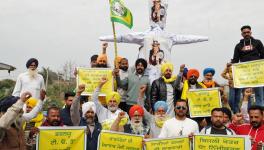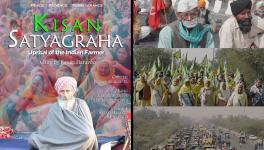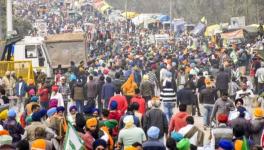Farmers’ Protest: Undying Spirit of Resilience and Care

It is as if winter arrives in India every year with a new metaphor of protest. Be it the anti-Citizenship Amendment Act (CAA), 2019, movement that flared up last year across the country or the ongoing farmers’ agitation against the three farm laws, the underlying fervour of these protests is indomitable. Thanks to Parliament sessions in which anti-people laws have been passed for two consecutive years, in the winter and monsoon sessions, these seemingly seasonal protests have churned the nation twice. The protesters held their ground both years despite facing the indelible ire of the ruling dispensation and the fury of the Covid-19 pandemic.
No matter how baseless and distasteful was Kangana Ranaut’s misidentification of Mohinder Kaur, a 75-year-old farmer from Bathinda, as Shaheen Bagh’s famous Bilkis Bano (endearingly referred to as Bilkis dadi), there prevails a sense of solidarity and determination among the protesters.
Shaheen Bagh and Singhu border—these sites in the national capital have come to represent the soul of India’s protesting ethos. An ethos that has been nurtured since the time of anti-colonial agitations based on non-violence and empathy, as opposed to brazen masculine virulence. Glimpses of the same empathy and care have been visible in the latest protests against the current regime in India.
Dissent, whether at the anti-CAA agitations or the farmers’ protests, comes with an unflinching rigour that perplexes the state as to how to respond. These protests signify hope and hold out the promise of fighting injustices firmly and sturdily. Students, farmers, Muslims, Dalits and political prisoners alike transform into a single community of protesters despite being met with similar propagandist flak.
Smear campaigns
For the smear-campaigners, Shaheen Bagh became equivalent to “Pakistan” because a majority of the protesters were Muslim and the farmers’ protest, with an overwhelming participation of Punjabis, has automatically come to represent “Khalistan”. A large chunk of the mainstream media has repeatedly attached adjectives such as “illiterate” and “backward” to the farmers—as they do to Muslims of the country who oppose the CAA. The theory of a “foreign hand” (be it Pakistan’s, China’s, or even Canada’s) inciting the farmers’ protests was fed with hollow exclamations about how the protesters are conversant in English or adept at using social media.
This is not the worst extent to which the illogic propagated by the mainstream media (popularly referred to as “godi media”) went. The press, in fact, flagrantly indulged in desperate lies as it faced a dearth of credible inadequacies to point out in these movements. It constantly maligned these protest sites by iterating the public inconveniences they may have caused. While a road blocked as a result of the protests is made to haunt public opinion, why does not the misery of the protesters translate into positive portrayal of their demands? As news of the Haryanvi cleric Baba Ram Singh’s alleged suicide pops up in the context of the farmer’s protest, the question remains, what systemic institutional injustice might have pushed him so far into desperation?
Values of Care and Self-Discipline
One of the striking similarities between both these protests is their sincerity and commitment towards the cause—a purpose that compelled protesters to sacrifice their earnings as they attended the gatherings at Shaheen Bagh, and which has led agrarian families to take turns to join the protests at Delhi’s Singhu border. A remarkable concoction of care and self-discipline makes these sites meaningful, and to a certain extent, larger than life.
Despite the wrongful depictions, the protesters at these sites had on several occasions cleared passages to allow ambulances to pass through, distributed food and water bottles free of cost, and maintained calm in order to prevent wrongful escalations. Not only did the by-lanes of Shaheen Bagh welcome all visiting protesters with open arms, mobile langars provided food to even journalists covering the protest. Individuals from the localities where the protests were being held also volunteered to arrange for the basic needs of protesters at Shaheen Bagh. Now, organisations such as Khalsa Aid and Gurudwara Bangla Sahib are at the forefront of similarly assisting protesting farmers.
Not only were the protesters materially prepared to tackle the needs of these long-drawn-out protests, they were also mentally ready not to bow down despite the cold weather. Additionally, there has been an astounding intermingling of faiths at the protest sites. While the Sikhs have made room for Muslim protestors to pray at the Singhu border site, Shaheen Bagh had stretched out its arms towards a huge pool of people belonging to an array of faiths.
Protesting Women: A Sign of Resilience
The role of women in both these protests has been noteworthy and commendable. While the images of burqa-clad Muslim women at Shaheen Bagh broke the preconceived conjectures of “backwardness” surrounding the sartorial practice, the non-farming classes, in time, have come to terms with the visibility of peasant women. These sites are a perfect example of the blurring gendered presuppositions of private-public demarcations that prevail in India.
At Shaheen Bagh, women made it their evening ritual to come and sit at the protest site after dealing with their chores in the daytime. At the farmers’ protest, women have either taken charge of managing all their family affairs in the absence of male members, who have come to Delhi for the protest. Or they are joining the protest alongside men. Besides their active participation, on both occasions, the support of women on the home front became a significant factor behind the construction of seamless protests.
While the pandemic meant a curtain call for the Shaheen Bagh protest, the ongoing farmers’ protest has peaked despite the threat of the virus. Again, despite notable points of comparison between the two, there are recognisable dissimilarities as well. The convergence of sentimentality towards the kisaan as one who grows food for the nation and an overwhelming number of the Sikh community having served in the military sets public perception in their favour, while what Shaheen Bagh received is an unabashed caricature of Muslims.
What determines where the road ahead leads is the way propaganda and political manipulations are tackled and successfully countered with the power of prudence, love and resilience, which forge the unstoppable spirit of India’s protest culture. Though the euphoria of this culture has been considerably blunted in the face of the Supreme Court delimiting protests to specific sites and granting the State greater leeway over the democratic discourse in the country, faith in people’s power remains the sole panacea for a dwindling democracy.
The author is a PhD candidate at the Centre for International Politics, Organization and Disarmament, JNU. The views are personal.
Get the latest reports & analysis with people's perspective on Protests, movements & deep analytical videos, discussions of the current affairs in your Telegram app. Subscribe to NewsClick's Telegram channel & get Real-Time updates on stories, as they get published on our website.
























